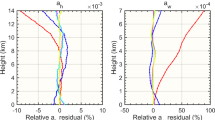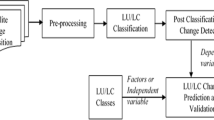Abstract
An algorithm of software complex is developed to process data of lidar gas analysis in IR wavelength range for a horizontal path of atmospheric sensing. The complex comprises: the module of writing data from atmospheric lidar sensing, module of absorption cross-section calculation, and module of methane concentration profile retrieval. The software complex for processing lidar gas analysis data, developed on the basis of the created algorithm, makes it possible to obtain retrieved methane concentration profiles along 1 km sensing path from the set of recorded return signals. The modules for writing data from atmospheric lidar sensing and for retrieving methane concentration profiles allow for a visual control of recorded return signals and retrieved methane concentration profiles. We present an example of retrieving methane concentration profile from lidar data that is obtained in Tomsk.






Similar content being viewed by others
REFERENCES
Romanovskii, O.A., Sadovnikov, S.A., Kharchenko, O.V., et al., Near/mid-IR OPO lidar system for gas analysis of the atmosphere: simulation and measurement results, Opt. Mem. Neural Networks, 2019, vol. 28, no. 2, pp. 1–10. https://doi.org/10.3103/S1060992X19010053
Yakovlev, S., Sadovnikov, S., Kharchenko, O., et al., Remote sensing of atmospheric Methane with IR OPO Lidar System, Atmosphere, 2020, vol. 11, no. 1, p. 70. https://doi.org/10.3390/atmos11010070
Mammez, D., Cadiou, E., Dherbecourt, J.-P., Raybaut, M., Melkonian, J.-M., Godard, A., Gorju, G., Pelon, J., and Lefebvre, M., Multispecies transmitter for DIAL sensing of atmospheric water vapor, methane and carbon dioxide in the 2 μm region, Proc. SPIE, 2015, vol. 9645, p. 964507. https://doi.org/10.1117/12.2194754
Robinson, I., Jack, J.W., Rae, C.F., and Moncrieff, J.B., Development of a laser for differential absorption lidar measurement of atmospheric carbon dioxide, Proc. SPIE, 2014, vol. 9246, p. 92460U. https://doi.org/10.1117/12.2068023
Robinson, I., Jack, J.W., Rae, C.F., and Moncrieff, J.B., A robust optical parametric oscillator and receiver telescope for differential absorption lidar of greenhouse gases, Proc. SPIE, 2015, vol. 9645, p. 96450U. https://doi.org/10.1117/12.2197251
Mitev, V., Borelli, R., Fiorani, L., Grigorov, I., Nuvoli, M., Palucci, A., Pistilli, M., Puiu, A., Rebane, O., and Santoro, S., Lidar extinction measurement in the mid infrared, Proc. SPIE, 2014, vol. 9292, p. 92923W. https://doi.org/10.1117/12.2075832
Yerasi, A., Tandy, W.D., Emery, W.J., and Barton-Grimley, R.A., Comparing the theoretical performances of 1.65 and 3.3 μm differential absorption lidar systems used for airborne remote sensing of natural gas leaks, J. Appl. Remote Sens., 2018, vol. 12. no. 2, p. 026030. https://doi.org/10.1117/1.JRS.12.026030
Zuev, V.E., Rasprostranenie lazernogo izlicheniya v atmosfere (Laser Radiation Propagation through Atmosphere), Moscow, Radio i svyaz Publ., 1981.
Vasil’ev, B.I. and Mannoun, U.M., IR differential-absorption lidars for ecological monitoring of the environment, Quantum Electron., 2006, vol. 36, no. 9, pp. 801–820. https://doi.org/10.1070/QE2006v036n09ABEH006577
Veerabuthiran, S., Razdan, A.K., Jindal, et al., Development of 3.0–3.45 nm OPO laser based range resolved and hard-target differential absorption lidar for sensing of atmospheric methane, Opt. Laser Technol., 2015, vol. 73, pp. 1–5. https://doi.org/10.1016/j.optlastec.2015.04.007
Ambrico, P.F., Amodeo, A., Di Girolamo, P., et al., Sensitivity analysis of differential absorption lidar measurements in the mid-infrared region, Appl. Opt., 2000, vol. 39, no. 36, pp. 6847–6865. https://doi.org/10.1364/AO.39.006847
Weitkamp, C., Lidar: Range-Resolved Optical Remote Sensing of the Atmosphere, Springer Science & Business, 2006, vol. 102.
Privalov, V.E. and Shemanin, V.G., Optimization of a differential absorption and scattering lidar for sensing molecular hydrogen in the atmosphere, Tech. Phys. Russ. J. Appl. Phys., 1999, vol. 44, no. 8, pp. 928–931.
Zuev, V.E., Makushkin, Yu.S., and Ponomarev, Yu.N., Sovremennye problemy atmosfernoj optiki. Spektroskopiya atmosfery (Modern Problems of Atmospheric Optics. Atmospheric Spectroscopy), Leningrad: Gidrometeoizdat Publ., 1987.
Gordon, I.E., Rothman, L. S., Hill, C., et al., The HITRAN2016 molecular spectroscopic database, J. Quant. Spectrosc. Radiat. Transfer, 2017, vol. 203, pp. 3–69. https://doi.org/10.1016/j.jqsrt.2017.06.038
Edwards, P.D., GENLN2: A General Line-by-line Atmospheric Transmittance and Radiance Model, NCAR Tech. Note, 1992, p. 147.
Bobrovnikov, S.M., Matvienko, G.G., Romanovskii, O.A., et al., Lidarniy spektroskopicheskii gazoanaliz atmosfery (Spectroscopic Lidar Gas Analysis of Atmosphere), Tomsk: Publishing House of the IAO SB RAS, 2014.
Terlouw, J.P., Vogelaar, M.G.R., and Breddels, M.A., Kapteyn documentation. https://https://readthedocs.org/projects/kapteyn/downloads/pdf/latest/. Accessed on March 20, 2020.
Rolf, C., Lidar observations of natural and volcanic-ash-induced cirrus clouds, Forschungszentrum Jülich, 2012. vol. 163.
Funding
The development of an algorithm for processing lidar gas analysis data was supported by the Ministry of Science and Higher Education of the Russian Federation (budget funds for IAO SB RAS). The development of a software package for processing lidar gas analysis data was carried out with the financial support of the Russian Foundation for Basic Research (Grant no. 19-45-700003).
Author information
Authors and Affiliations
Corresponding author
Ethics declarations
The authors declare that they have no conflicts of interest.
About this article
Cite this article
Nevzorov, A.A., Romanovskii, O.A., Sadovnikov, S.A. et al. Algorithm of Processing Data from Lidar Sensing of Methane in the Atmosphere. Opt. Mem. Neural Networks 30, 97–104 (2021). https://doi.org/10.3103/S1060992X21020041
Received:
Revised:
Accepted:
Published:
Issue Date:
DOI: https://doi.org/10.3103/S1060992X21020041




